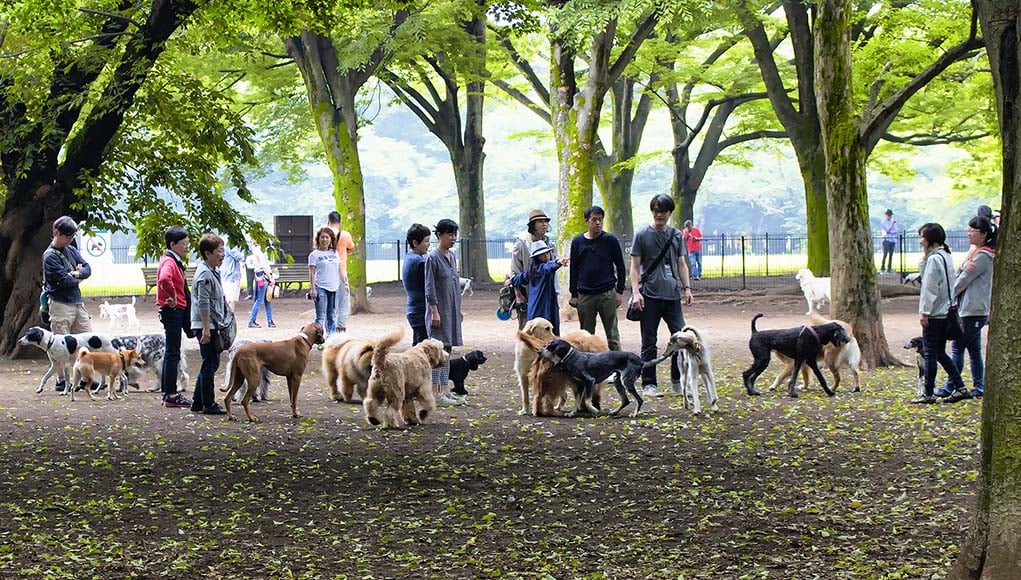Enjoying summer with your pooch in a dog park while he runs around freely can be fun, and it's also be a great way to provide your dog with exercise and to let him socialize with other dogs. However, dog parks can be dangerous as well – and we've written some horror stories before – especially if you are not prepared for potential problems. Let's cover some of the most common reasons why dog parks can be dangerous to pet owners and their dogs.
Aggressive Behavior
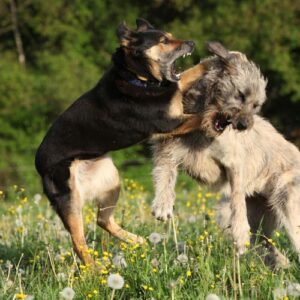 There are many cases where aggressive behavior of dogs leads to an attack. This often results in serious injuries and in some cases can even have fatal results.
There are many cases where aggressive behavior of dogs leads to an attack. This often results in serious injuries and in some cases can even have fatal results.
Excitement at busy dog parks is always at a high level, which can make even the well-trained dogs aggressive for multiple reasons. Here are some of them below.
Rough Play
Dogs can have different playing styles and often two dogs with incompatible playing styles can get into a fight. One dog may play more roughly, while the other dog can take that as a sign of aggression. This can especially be a problem when one dog is much smaller than the other because it can lead to injuries even when dogs are just playing.
If your dog is used to playing rough with other dogs, train him to be gentle when he plays by letting him play with smaller dogs in a controlled environment. On the other hand, if you notice that your pet has engaged in a rough play when that’s not his usual style, talk to the owner of the other dog and try to break the dogs apart before the situation escalates.
Resource Guarding
In a dog park, resource guarding can be a big problem since resources are scarce and valuable. Dog toys are the most common possession that dogs fight over but this can also be about food and other items which a dog may consider their “own resource”.
Leave your dog’s toys at home and avoid giving him food in the park to prevent resource guarding and dangerous results it can lead to.
Other Types of Aggression
Aggression in dogs can also come from frustration from being on the leash leash, which then gets the best of the dog when he gets out of his leash.
Facilitated aggression can happen when a dog is too attached to his owner, which can make him feel afraid of other dogs or possessive of his owner.
Age differences can also lead to fights in some cases because older dogs are often not fond of energetic play and may start to growl and threaten other dogs that come near them to play.
ALSO READ: Going to a Dog Park for the First Time? 12 Things You Must Know
Crowded, Poorly Structured/Fenced Dog Parks
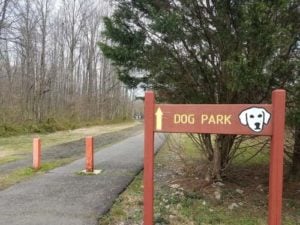 If going for the first time, to ensure the safety of your canine, visit the dog park without your pooch to observe the size, structure and atmosphere of the park. Make sure that the park is large enough because dogs can get aggressive if they feel crowded in a small area.
If going for the first time, to ensure the safety of your canine, visit the dog park without your pooch to observe the size, structure and atmosphere of the park. Make sure that the park is large enough because dogs can get aggressive if they feel crowded in a small area.
Check out how busy the park is and try to visit it a few times to see when it the busiest. Take your dog when it is the least busy first so you can have more control.
Another thing to check out is whether dogs congregate in packs there. Pack mentality can lead to aggression towards the new, unfamiliar dogs. Never let your pooch close to a large group of dogs, especially if he doesn’t already know them.
Park Structure
Some dog parks have separate areas for small and large dogs. This is a great idea because the sheer difference in size can often lead to injuries. Putting together small and large breeds is an accident waiting to happen.
Take a look at the fence of the park to ensure that your pooch can’t escape from the park. He shouldn’t be able to jump over it or crawl underneath. There should be multiple entrances/exits and they need to be double gates to ensure safety because dogs often congregate at the entrance/exit.
Irresponsible Dog Owners
Owners who bring untrained dogs to dog parks or don’t pay attention when their pets are off leash can present bigger danger than responsible owners with aggressive dogs.
When you go to the dog park, your focus should always be on your dog when he is off his leash. If you also want to socialize with other dog owners, make sure that your dog is on a leash, otherwise you may not be able to react quickly if something happens.
Health Concerns
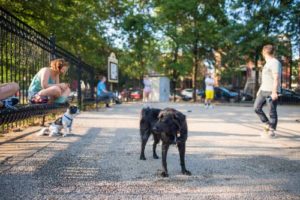
Any place with a large group of animals together poses multiple health concerns and dog parks are not an exception.
Infectious Diseases
Similarly to risks of boarding a dog, with so many dogs in one place, infectious diseases like canine influenza, kennel cough or parvovirus can easily spread.
If you plan to take your dog to a dog park, make sure that his vaccines for parvovirus and kennel cough are up to date. Parvovirus vaccine is especially effective and important because this disease can even be fatal for dogs in some cases and treatment for it can be very expensive.
Parasites
Dog parks are a paradise for parasites, both external like ticks and fleas and internal, like roundworms and hookworms.
Fleas and ticks can be passed from one dog to another but ticks can also be found in the grass. Use tick and flea protection before you take your dog to the park, whether you choose an oral tablet, topical ointments or preventive collars. Don’t forget to check your dog for ticks and fleas when you come home from the park.
Intestinal parasites, usually different types of worms, are mostly found in unsanitary conditions and dog feces. Always clean after your dog and don’t be afraid to tell other dog owners to do so as well.
Insect Bites
While insect bites are usually nothing more than a painful and temporary issue, some dogs can also be allergic to bee stings just like some humans are.
If you notice that your dog has been bitten by a bee, try to find and remove the stinger and put some ice on the bite area. If your dog’s face starts to swell or your dog exhibits signs of extreme pain, take him to the vet immediately.
Heatstroke
Heatstroke is another common health problem which can happen in a dog park, especially in the summer. It is a potentially deadly issue, so take the necessary steps to ensure it doesn’t happen.
First of all, don’t take your dog to the park at the hottest time of the day. Make sure that your dog is well-hydrated at all times. If the temperature is too high, look for some shade. There should be plenty of trees in the park where your dog can find refuge from the heat.
You should be especially careful if you have a brachycephalic dog because dogs with flat or short snouts are particularly prone to heatstroke since they can’t properly cool themselves off by panting.
It is important to know how to recognize signs of heatstroke in dogs, which include drooling, lethargy, vomiting and collapse, among others. If you suspect that your dog is having a heatstroke, take him to the vet as soon as possible.
Cuts, Bites and Other Injuries
Cuts and bites are a common result of an altercation between dogs, which is unfortunately not a rare occurrence in dog parks. Bite wounds and cuts can become infected, so take your dog to the vet to treat them with antibiotics.
Other injuries like sprains and soft tissue injuries can happen when your dog jumps or runs and more often than not, they can’t really be prevented.
If you notice that your dog is limping or seems in pain, cut the session short and take your pooch home to get some rest. If the problem persists, a vet appointment may be necessary.
Conclusion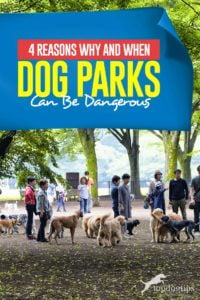
Dog parks can be a perfect way for your dog to socialize, play and get some exercise but you need to take all the necessary precautions to prevent injuries and other problems.
Make sure that your dog is healthy and vaccinates, that's he's well-trained and otherwise suitable for dog parks before you take him there. Always keep your pooch in sight when you are in a dog park, especially if you let him off the leash.
READ NEXT: 25 Ways to Be a Responsible Dog Owner


